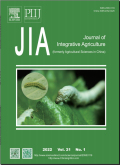首页|期刊导航|农业科学学报(英文)|Functional characterization of sensory neuron membrane protein 1a involved in sex pheromone detection of Apolygus lucorum(Hemiptera:Miridae)
农业科学学报(英文)2024,Vol.23Issue(12):4120-4135,16.DOI:10.1016/j.jia.2024.03.043
Functional characterization of sensory neuron membrane protein 1a involved in sex pheromone detection of Apolygus lucorum(Hemiptera:Miridae)
Functional characterization of sensory neuron membrane protein 1a involved in sex pheromone detection of Apolygus lucorum(Hemiptera:Miridae)
摘要
关键词
mirid bug/pheromone perception/sensory neuron membrane proteins/expression profile/receptor interaction/evolutionKey words
mirid bug/pheromone perception/sensory neuron membrane proteins/expression profile/receptor interaction/evolution引用本文复制引用
Yan Li,Xingkui An,Shuang Shan,Xiaoqian Pang,Xiaohe Liu,Yang Sun,Adel Khashaveh,Yongjun Zhang..Functional characterization of sensory neuron membrane protein 1a involved in sex pheromone detection of Apolygus lucorum(Hemiptera:Miridae)[J].农业科学学报(英文),2024,23(12):4120-4135,16.基金项目
This work was supported by the National Natural Science Foundation of China(32150410366,31972338,and 32372639),the earmarked fund for China Agriculture Research System(CARS-02-26),the National Key Research and Development Program of China(2021YFD1400700),and the Special Grant of China Postdoctoral Science Foundation(2022T150712). (32150410366,31972338,and 32372639)

